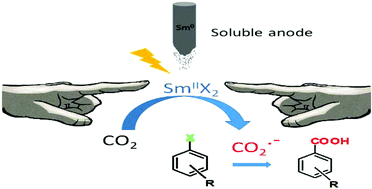CO2 activation by electrogenerated divalent samarium for aryl halide carboxylation†
Abstract
The reductive carboxylation of aryl halides has been investigated using a samarium electrode as a sacrificial anode to yield the corresponding benzoic acids, providing a smooth strategy for CO2 activation. Carboxylation occurred after an efficient reduction of carbon dioxide mediated by an electrogenerated Sm(II)-complex acting as a strong monoelectronic reductive reagent.

- This article is part of the themed collection: Synthetic methodology in OBC


 Please wait while we load your content...
Please wait while we load your content...